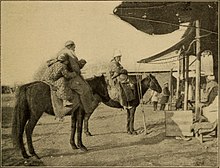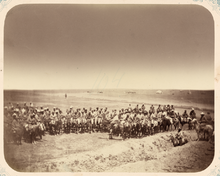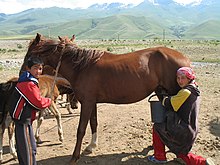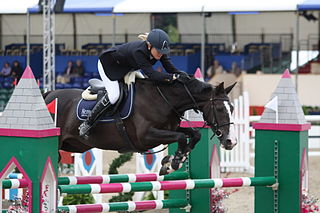
The Selle Français (SF) is a breed of sport horse from France. It is renowned primarily for its success in show jumping, but many have also been successful in dressage and eventing. An athletic horse with good gaits, it is usually bay or chestnut in color. The Selle Français was created in 1958 when several French riding horse breeds were merged into one stud book. The new breed was meant to serve as a unified sport horse during a period when horses were being replaced by mechanization and were transforming into an animal used mainly for sport and leisure.

The Camargue, French: Camarguais or Cheval de Camargue, is a traditional French breed of working horse indigenous to the Camargue area in southern France. Its origins are unknown. For centuries, possibly thousands of years, these small horses have lived wild in the harsh environment of the Camargue marshes and wetlands of the Rhône delta, which covers part of the départements of Gard and Bouches-du-Rhône. There they developed the stamina, hardiness and agility for which they are known today. Traditionally, they live in semi-feral conditions in the marshy land of the region. The Camargue horse is the traditional mount of the gardians, the Camargue riders who herd the black Camargue bulls used for courses camarguaises in southern France.

The Novokirghiz or New Kirghiz is a modern Kyrgyz breed of horse. It was developed in the Kirghiz Soviet Socialist Republic in the mid-twentieth century through cross-breeding of the traditional Kyrgyz Horse of the region with introduced horses of Thoroughbred, Don and Anglo-Don stock.

The Poitevin or Poitou is a French breed of draft horse. It is named for its area of origin, the former province of Poitou in west-central France, now a part of the region of Nouvelle-Aquitaine. It was formed in the seventeenth century when horses of Flemish or Dutch origin, brought to the area by engineers working to drain the Marais Poitevin, interbred with local horses. Although it has the size and conformation of a draft horse, the Poitevin has never been bred for draft abilities, and has been little used for draft work. Its principal traditional use was the production of mules. Poitevin mares were put to jacks of the large Baudet du Poitou breed of donkey; the resulting Poitevin mules were in demand for agricultural and other work in many parts of the world, including Russia and the United States. In the early twentieth century there were some 50,000 brood mares producing between 18,000 and 20,000 mules per year.

The Anglo-Norman horse is a warmblood horse breed developed in Lower Normandy in northern France. A major center of horse breeding, the area had numerous regional types that were bred to one another and then crossed with Thoroughbreds to form the Anglo-Norman. Various body types developed within the Anglo-Norman breed, two of which were split off to form the Norman Cob and French Trotter. The remaining types were eventually standardized, although there remained some criticism of the "hybrid" nature of the breed's conformation. However, it is successful as an international sport horse, especially in the sport of show jumping. The Anglo-Norman also contributed to the development of several other breeds in Europe and Asia.

The Norman Cob or Cob Normand is a breed of light draught horse that originated in the region of Normandy in northern France. It is of medium size, with a range of heights and weights, due to selective breeding for a wide range of uses. Its conformation is similar to a robust Thoroughbred, and it more closely resembles a Thoroughbred cross than other French draught breeds. The breed is known for its lively, long-striding trot. Common colours include chestnut, bay and seal brown. There are three general subsets within the breed: horses used under saddle, those used in harness, and those destined for meat production. It is popular for recreational and competitive driving, representing France internationally in the latter, and is also used for several riding disciplines.

The Henson Horse, or Cheval de Henson, is a modern horse breed from northeast France. It was created by the selective breeding of light saddle horses with the smaller, heavier Norwegian Fjord horse to create small horses suitable for the equestrian vacation industry. The breeders' association, Association du Cheval Henson, was formed in 1983. In 1995 the studbook was closed to horses not born from Henson parents, and in 2003 the breed was officially recognised by the French government agencies for horse breeding. A hardy breed of horse, each winter the broodmares and youngstock from several breeders are let loose together to graze freely in the wetland reserves in France.

The Kyrgyz Horse or Kirgiz Horse is a traditional breed of small horse from the Kyrgyz Republic (Kyrgyzstan). Kyrgyz people associate it with their nomadic past. During the Soviet era of Kyrgyz history, the Kyrgyz Horse was cross-bred with imported foreign breeds, including Don and Thoroughbred strains, to create a new and larger breed, the Novokirgiz or New Kirgiz.

The minor presence of horses in Togo comes out of a few breedings and practices of equestrianism represented, at the end of the 19th century and at the beginning of the 20th century, in the region of Mango and in the north of the current country. Horses were introduced at that time thanks to the Tem, who were the founders of a small kingdom that focused on the use of rifles and cavalry. The distribution of horses in the south is much more recent, as breeding was very limited due to the presence of the tsetse fly. After sporadic imports of horses by German and French colonial troops, a diplomatic gift from Niger in the 1980s allowed the creation of the first Togolese honorary cavalry regiment. The use of the horse-drawn vehicle has always been unknown in Togo.
The National Stud Farm of Chaouchaoua is a stud in Tiaret in Algeria. The institution is dedicated to the preservation and improvement of Algerian horse breeds, founded in 1874. It is now a center of expertise for issues related to breeding and care of equines.
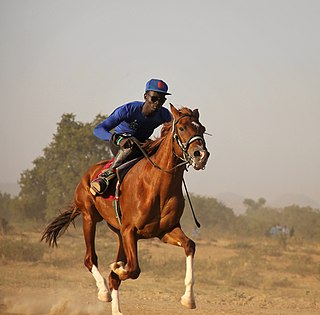
The history of horses in Cameroon is linked above all to the traditional presence of this animal in the northern regions of the country, around Lake Chad from the 16th century, then in Adamawa, as well as in the Garoua and Maroua regions. Traditional equestrian practices in Cameroon, such as horse parades and horse dances, have more recently been joined by equestrian activities, under the influence of Western expatriates and investors, notably in Yaoundé since the 1990s. The main use of horses in Cameroon is in agriculture and transport fields.
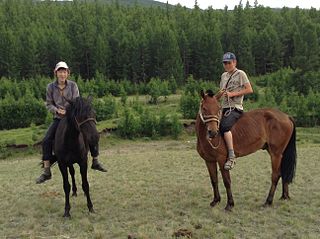
The Tuva is a breed of small saddle horses native to the Tuva region of Russia. Classified among the "Siberian pony" family, it proves to be much closer to the Mongolian horse, having lived relatively isolated from other Asian and Eastern European horses. It has long been ridden by the nomadic horse riders of its region, for breeding and hunting. At the end of the 19th century, mineral extraction led to the import of draft horses and saddles, giving rise through crossbreeding to the Upper Yenisei horse, now very rare, and the Tuva carriage horse, now extinct.

In China, horses are present both physically and in art and beliefs, particularly those relating to astrology. In 1985, China had the world's largest herd of horses, numbering 11 million. China was at the origin of post houses in Eurasia. Since the 2000s sport and leisure riding have been developing in China, mainly for wealthy people.

The Barraquand horse is a French mountain horse breed. It is the result of an ancient selection process in the Vercors Massif, and it may have originated from a small herd of animals selected by religious communities, notably those established in the Léoncel abbey. It takes its name from the Barraquand family, who developed their breeding from the late 19th century to the 1950s, thanks to the practice of transhumance. Considered lost after the bankruptcy of the original Barraquand breeding operation and the sale of part of their land in 1963, the breed has been reconstituted since the 1990s, thanks to the initiative of several breeders and local institutions, in particular the Barraquand family, the Vercors Regional Natural Park and the Annecy National Stud.
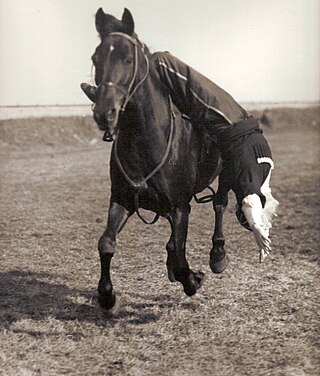
The presence of horses in Russia is attested by prehistoric fossils and has been constant throughout its history, particularly during the Soviet era, thanks to the integration of territories with a strong equestrian tradition. Trick riding stems from the military traditions developed by the Russian Cossacks. Russian equestrian culture is characterized by the exclusive use of the "duga" yoke, known in particular through the troika.
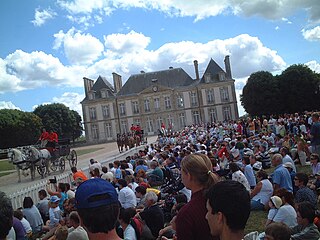
Horses in Normandy have a clear economic importance, particularly through breeding. Present since the Bronze Age, horse breeding developed with the establishment of the Haras du Pin stud farm. Horses are still a very much alive tradition in this region. Normandy boasts a number of renowned racecourses, in particular the one in Deauville, where events take place regularly, including international ones such as the 2014 World Equestrian Games.
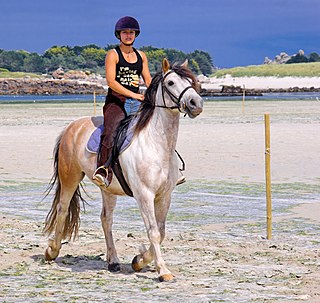
Leisure horses are intended for pleasure riding, and in particular for trail riding by private individuals. Difficult to define, it is above all an animal endowed with particular qualities, rather than a precise breed. It must be versatile and calm in character, with a willing and courageous mind. As early as the 1970s, breeders such as those of the Swiss Freiberger or Franches-Montagnes were breeding animals for this then-new use. The market for leisure horses is now buoyant. France has created "leisure qualifications" for this purpose.
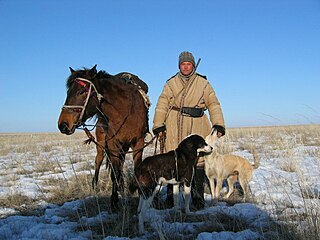
The Adaev is a horse breed for riding and light draft. It is native to the desert regions of southern Kazakhstan and is one of the two types of the Kazakh breed, along with the Jabe. Finer and less hardy than the Jabe, the Adaev is an "Oriental Turk" type. It is mainly used for local equestrian sports and herding. Mares are milked for their milk. Like most Kazakh horses, the Adaev is sometimes slaughtered for its meat, although this is only a secondary purpose. Little known outside its native area, the Adaev has spread to neighboring Turkmenistan and Uzbekistan, with nearly 29,000 individual horses counted in 1990.

The Amourski, also known as Amur horse or Manchurian pony, is an extinct breed of small Siberian and Manchurian horses. Formed in the early 19th century, it originated from the area around the Amur River in northeast Asia, in Russia and China. These small horses, more refined than other Siberian breeds, were usually ridden or driven, and were known for their hardiness.

Horses in Morocco are an ancient tradition, linked to the history of the Berber cavalry. The Barb and Arab-Barb breeds are considered a national heritage in Morocco, having been bred by numerous local tribes. Tbourida, the most popular Moroccan equestrian sport, showcases the military use of the Barb or Arab-Barb horse. The country boasts five national stud farms in Marrakesh, Meknes, Bouznika, Oujda and El Jadida. It organizes major international equestrian events, such as the El Jadida International Horse Show and the Morocco Royal Tour, as well as national sporting events, such as the Rabat Horse Week.

